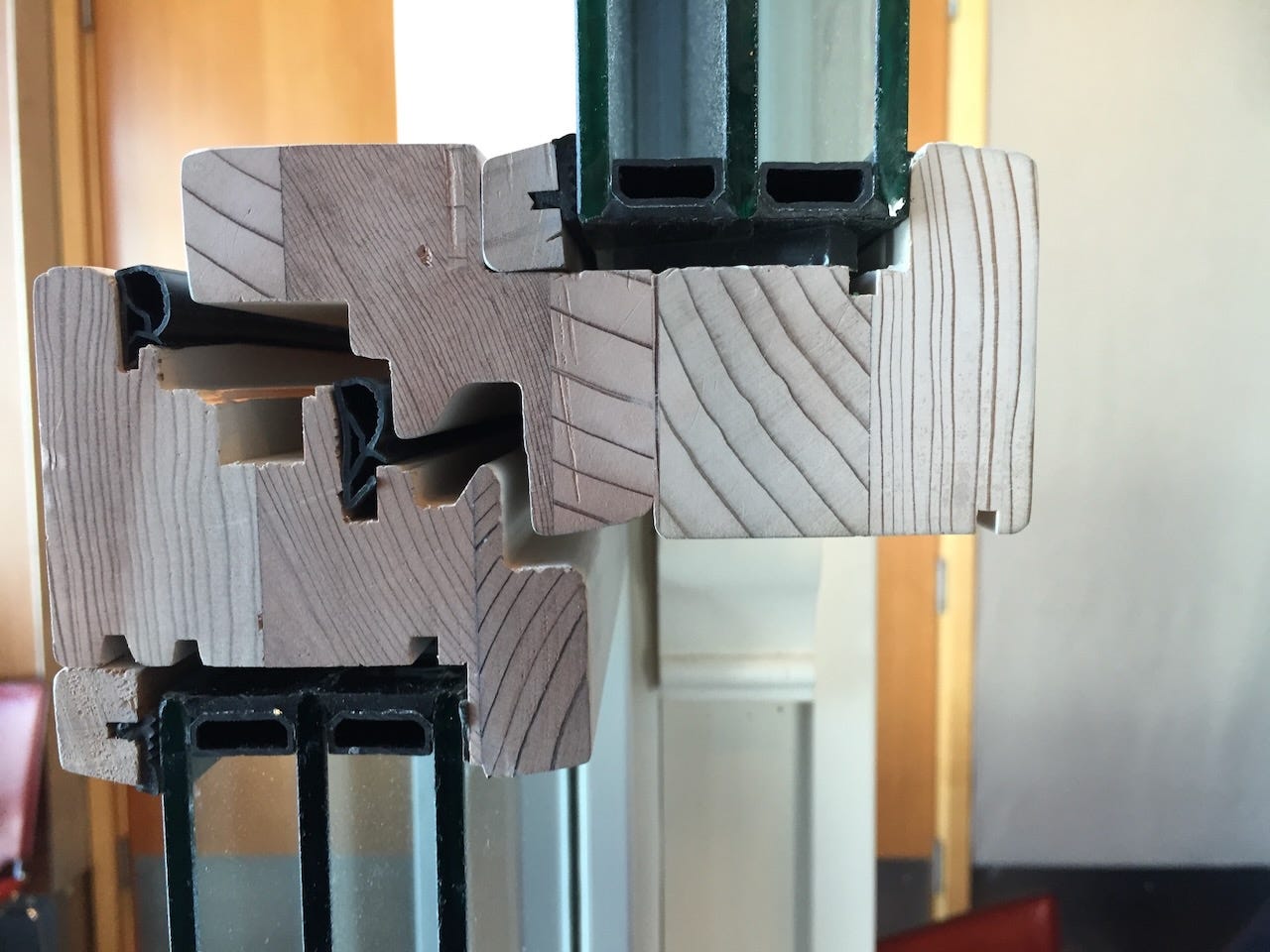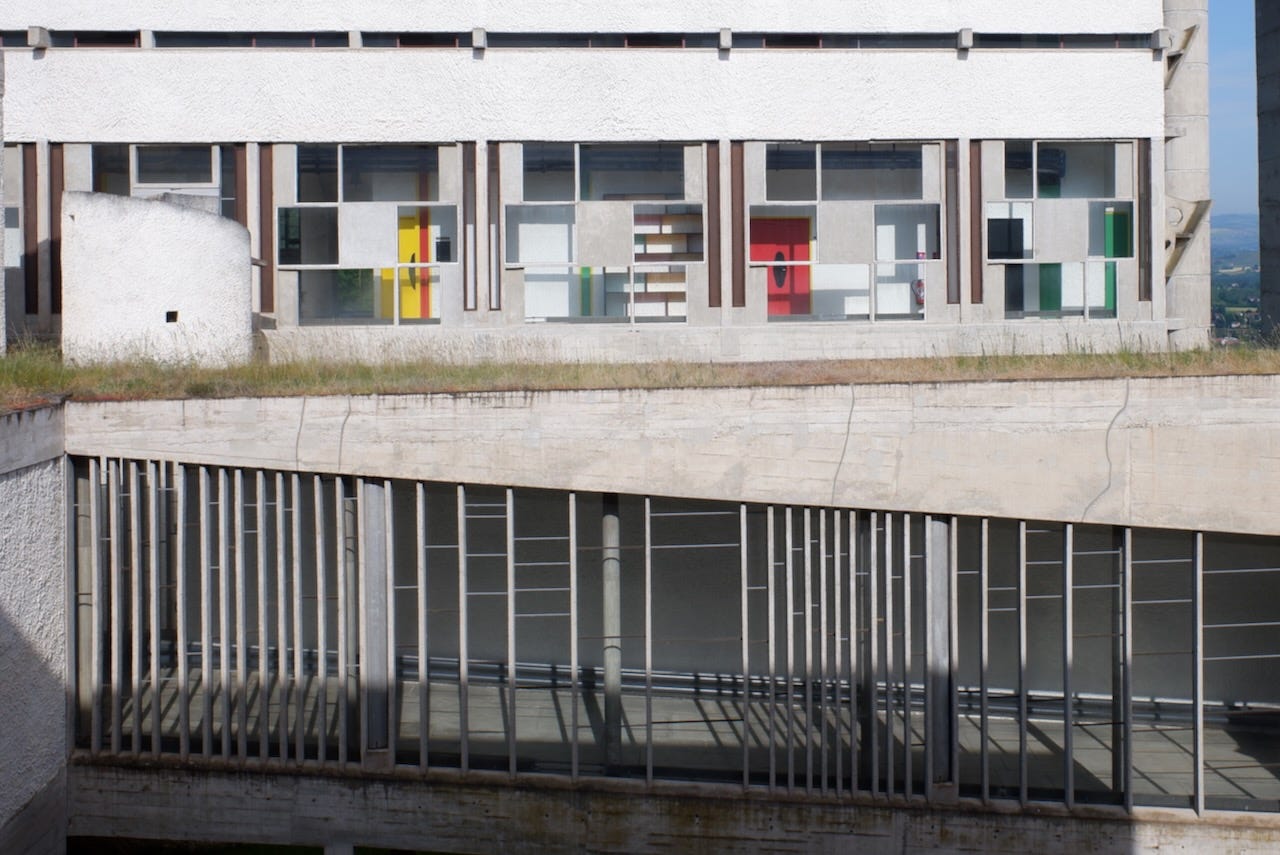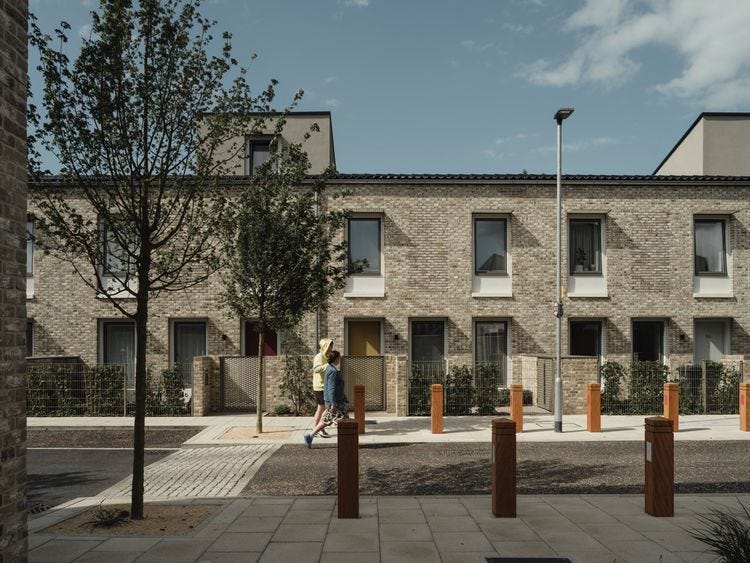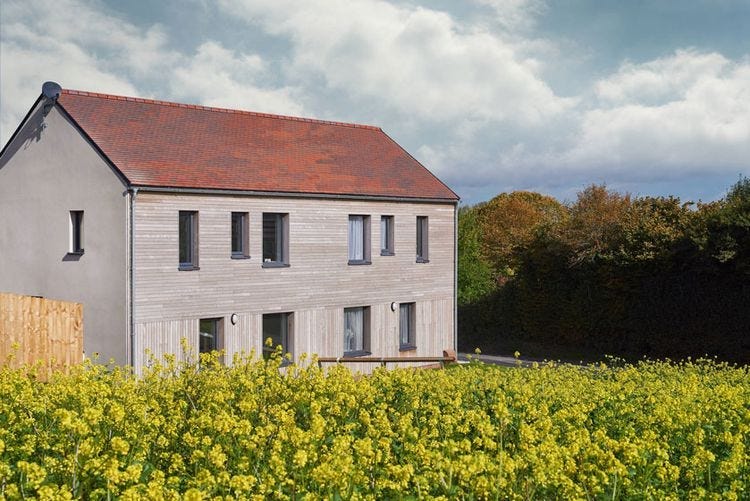Looking at windows: excerpts from The New Manual
In which I go from small windows to thinking big.
I recently wrote a post about coatings on windows while digesting Lisa Heschong’s book Visual Delight in Architecture: Daylight, Vision and View, and I am rethinking some of my long-held views of windows. I have been working on my next book, The New Manual of the Dwelling, and I had written a section on windows, which may need a rework. I have decided to publish an excerpt here; longtime readers may recognize some of it from previous posts. It’s long, and I look forward to readers’ thoughts.
The last time I saw my friend Monte Paulsen alive was in Denver in 2023 when he was doing a test run of his three-hour lecture on Passivhaus design in a heating world. He called for “windows with purpose”-
“Over-glazing brings high heat loss, overheating, storm damage, and costs more. Only place a window where it has a specific purpose and where it is the best solution to serve that purpose. Common purposes: light, view, ventilation.”
Today, we have LED lights and mechanical ventilation. We even have TV screens where you can choose your view. So, what is the purpose of a window?
200 years ago, this would have been a silly question. Windows were a hard-working, carefully thought-out piece of climate control. They were often double-hung so that they could be tuned to maximize ventilation. There would be two in every room for cross-ventilation. They had operable shutters for shading, security and privacy while still maintaining ventilation. There was an overhanging cornice to keep the rain off. There might be a sheer drape inside to cut glare and heavy drapes for keeping in the heat in winter. They were tall to let light deep into the room. But they didn’t come down too close to the floor; glass was expensive, and you didn’t make the window any bigger than it had to be. This was a hard-working, carefully thought-out piece of climate control. There is not a motor to be seen, and 200 years later, it still works.
Today, window size and design are primarily a matter of aesthetics, and designers make them too big. This is a problem as a good window is thermally worse than a bad wall. Windows are expensive, and they have high upfront carbon emissions. Which brings us back to Monte’s question: What is the purpose of a window? How do you address Monte’s three common purposes?
Light
Historically, glass was expensive and came in small pieces, assembled into windows with lead strips. In most homes, openings were sealed with shutters, if they were sealed at all; before chimneys were developed in the 16th century in England, you needed a lot of fresh air and openings to let the smoke out. It wasn’t until the 17th century, with the introduction of crown glass in1 that we got bigger panes and sash windows2 and it took until the 18th century to get our double-hung “six over six” windows that became almost the standard.
Now, windows could admit lots of light, and the introduction of chimneys and stoves meant that buildings and homes could be sealed, giving us comfort as well. Alas, like solar power today, they didn’t work at night. But in the daytime, it was plentiful and free. In England, it is even protected as “ancient light.”3 Artificial light, on the other hand, was incredibly expensive; according to research by William Nordhaus,4 awful and smelly tallow candles cost 40 cents in modern money per 1000 lumen-hours; a decent sperm-whale oil light cost $1.60 per thousand lumen-hours in 1855. Edison’s electric filament bulb changed everything, dropping the price to 6 cents by 1990.
However, that Edison bulb still needed lots of electricity to run, and until recently, most of that electricity came from burning coal. Throughout the energy crisis, architects and engineers developed elaborate schemes for maximizing daylight, including light shelves, light tubes and pipes, and even fibre optics to bring daylight into interior spaces.
There are studies5 recommending we “Replace artificial light with daylighting and use lighting sensors to avoid demand for lumens from artificial light.” But that is no longer true; we have to change the way we think about the modern window and daylighting.
Light-emitting diodes (LEDs) and cleaner electricity turn everything on its head; running a thousand-lumen LED costs a tenth of a cent in 2024 dollars per thousand lumen-hours, probably half that in Nordhaus’s 1996 dollars. It’s essentially free. A window, on the other hand, is not free; you might get the light, but you also have heat loss or heat gain. I tried to do the math and figure out how much a window admitting a thousand lumens cost in terms of additional heating or cooling, and it was beyond me; I put the question to engineer Nick Grant, who responded:
"Quite possible that modern LEDs could be more efficient than windows, but I’d take that as a reason not to overdo the windows rather than to avoid windows! In terms of doing the sums you could prove anything depending on assumptions. Despite my banging on about efficiency and sufficiency, I’m partial to the odd window placed for a Zen view or mid-winter sunbeam that does nothing for heating or daylight but lifts the spirits.”
Circadian Rhythms
Nick, the engineer, makes a very un-engineer-like point. One reason that daylight lifts the spirits is it changes through the course of the day and our bodies and minds respond to this. Helen Sanders and Pekka Hakkarainen wrote in 2014:6
“Over recent years, a large amount of data has accumulated demonstrating the harmful effects on human health due to lack of daylight and exterior views. The human body’s circadian rhythms not only manage sleep-wake cycles, but also many other important biological functions of the body such as hormone production, weight management, and immune systems. The production and suppression of melatonin is key to the regulation of these functions, and this is triggered by the light-dark cycles of daylight.”
This was confirmed in 2017 with the Nobel Prize for Medicine, given to Jeffrey C. Hall, Michael Rosbash and Michael W. Young for figuring out circadian rhythms. From the Nobel announcement:
“The biological clock is involved in many aspects of our complex physiology. We now know that all multicellular organisms, including humans, utilize a similar mechanism to control circadian rhythms. A large proportion of our genes are regulated by the biological clock and, consequently, a carefully calibrated circadian rhythm adapts our physiology to the different phases of the day. Since the seminal discoveries by the three laureates, circadian biology has developed into a vast and highly dynamic research field, with implications for our health and wellbeing.”
In his recent book, Constructing Health, architect Tye Farrow notes the importance of natural light:
“One compelling study connecting light with human performance compared the test scores of more than 20,000 students, primarily on the West Coast of the United States. It found that students with the most balanced daylight in their classrooms performed 20 percent better in math tests and over 25 percent faster on reading tests than students in classrooms with poor lighting or glare."
As Debra Burnet, a daylighting designer and specialist on the impact of daylight on human health and well-being, noted in Construction Specifier, “Daylight is a drug, and nature is the dispensing physician.” We need that drug, even in our bedrooms.
Biophilia
The term Biophilia was coined by psychologist Erich Fromm and popularized by E.O. Wilson in his 1984 book “biophilia.” He described it as “humanity’s innate response to nature and connection to natural systems.” It means "love of life" and suggests that there are significant health benefits to being able to see plants and trees. I thought it all a bit touchy-feely until I interviewed architect Tye Farrow, who studied neuroscience as well as architecture and writes:
"Experiencing nature—in ways as simple as a stroll in the woods—is proven to improve physical and mental health in myriad ways. The natural experience lowers blood pressure, reduces heart rate and muscle tension. It reduces anxiety, increases emotional resiliency and boosts the sense of well-being. Architecture and design that is inspired by nature and the natural world can bring these health-promoting advantages to visitors. Examples include the use of natural light, natural materials, and shapes and structures that are reminiscent of natural spaces."
Richard Neutra preached “bio-realism” to capture “the inherent and inseparable relationship between man and nature.” He tried to make windows disappear so that inside became outside, often supporting the roof with a “spider leg” way outside of the building so you couldn’t tell where it started and where it ended. I would argue rather that a window should act like a picture frame.
Happiness and connection
Fascinating research7 by Kiran Maini Gerhardsson and Thorbjörn Laike in Sweden found that windows provide much more than light and air;
"Windows represent an enjoyment of the home and fulfil much more than physical needs. They must allow sufficient personal control over fresh and cool air, sound, sunlight, streetlighting and privacy."
Interviewees preferred natural light "because it varies, increases room brightness and improves mood." The authors conclude:
There is much more to such experiences than the satisfaction of physical needs (modulating indoor temperatures, blocking exterior noise or enabling visual tasks). Perceiving a room to be adequately daylit, pleasant and spacious seems to be equally essential, and a view of the world outside brings information to inhabitants. However, windows also need to screen the gaze of people outside from peering in, moderate bright sunlight during the day.
Ventilation
When I was a baby, my mother would put me in a hamper out on the fire escape of her Chicago apartment to get my daily requirement of fresh air, even in the middle of winter. Once, the cleaning woman in the apartment upstairs dumped a bucket of dirty water out the window and soaked me; I almost froze to death. But it was a common belief that children should be aired and that people should sleep with the windows open, even in winter. Doctor Benjamin Spock, whose 1946 book “Baby and Child Care” was the bible for bringing up boomers, wrote:
Changes in air temperature help tone up the body's system for adapting to cold or heat. A bank clerk is much more likely to become chilled staying outdoors in winter than a lumberjack. A baby living continuously in a warm room usually has a pasty complexion and may have a sluggish appetite.
My mom believed all this. Before I was born, my parents lived in Fort Wayne, Indiana, and my mom had a brand new Studebaker convertible. She also had a bum knee from a ski accident and found walking painful, so she would put my sister in the back seat and drive around Fort Wayne with the top down in the middle of winter- my dad would get calls at work about his crazy wife. But she believed Dr. Spock:
Cool or cold air improves appetite, puts color in the cheeks, and gives more pep to humans of all ages.... I can't help but believe in the tradition.
Where did the tradition come from? Dr. Spock probably got it from Dr. Luther Emmett Holt, who wrote “The Care and Feeding of Children”1 in the 1890s. Dr. Holt prescribed "airing" of babies and children, keeping rooms very cool, and sleeping with windows open unless it is below freezing. Airing the baby meant dressing her up and opening all the windows, even in winter, starting when the child was a month old. His book was written as a Q and A:
Of what advantage to the child is going out? -Fresh air is required to renew and purify the blood, and this is just as necessary for health and growth as proper food.
What are the effects produced in infants by fresh air? -The appetite is improved, the digestion is better, the cheeks become red, and all signs of health are seen.
Dr. Holt had firm ideas about temperature:
At what temperature should a nursery be kept during the day? -Best, 66° to 68° F., measured by a thermometer hanging three feet from the floor. Never should the temperature be allowed to go above 70° F.
At what temperature during the night? -During the first two or three months, not below 65° F. After three months the temperature may go as low as 55° F. After the first year it may be 50° or even 45° F.
Then there was Dr. Joseph Edwards, who believed we should all live in tents, or as close to it as possible. In his book, How We Ought to Live2, he writes:
“I am sure we would all enjoy better health, if houses were unknown, and we lived in tents or in the open air, as animal life in a state of nature is accustomed to do.”
Where today, architects and Passivhaus nerds try to make houses as airtight as possible, Edwards wanted them leaky, certainly not to Passivhaus standards: "Natural ventilation by means of window and door cracks, the porous walls etc, will change and purify this air three times in the course of an hour."
And windows? Too much is never enough.
“Large windows and large doors will help much to make a healthy house. You cannot have them too wide and too high. You remember what I said about tent life. The larger you make your openings, the nearer will your house approach a tent.”
Then, we have the response to the Influenza pandemic of 1918. In Europe, we had the sanitarium movement and the birth of modernism, with Aalto, Le Corbusier and Pierre Charreau promoting light, air and openness; Neutra brought it to America with his Lovell Health House. But there was also the Fresh Air Movement, which advised citizens to "Keep your bedroom windows open [to] prevent influenza, pneumonia [and] tuberculosis." According to heating expert and author Dan Holohan3, engineers designed heating systems “for the coldest day of the year with the wind blowing and the windows open”
Of course, there was a price to pay for this in coal, and there is a price to pay today in energy losses and carbon emissions. Natural ventilation also isn’t helpful when the outside air is dirtier than the inside air from PM2.5 emitted from car exhaust or forest fires.
Natural ventilation also doesn’t really work unless you have cross-ventilation. As Ted Kesik’s drawing shows, a single window opening, as shown on the bottom left, means there is very little effective ventilation.
It is also no longer enough in a heating climate; as Monte Paulsen noted, “every multi-family building requires external shading as well as mechanical cooling to remain habitable in the coming decade.”
My mom listened to Dr. Spock, but today, we should all be listening to Monte Paulsen.
Upfront Carbon and Windows
Today, we can build our homes out of wood and straw, but our windows are still made of glass. In commercial buildings, the frames are often made of aluminum. They all have higher upfront carbon emissions than just about any other building product.
This is true whatever the frames are made of; it’s just a matter of degree. According to the BEAM calculator, a double-glazed window with a wood frame emits about 72 kg of CO2 per square meter; vinyl frames are at 86 kg/m2; wood with aluminum cladding, a very popular high-end window frame, are even greater at 99. They are all high.
Most high-performance windows are now triple-glazed, which makes the frames and hardware chunkier and heavier and increases the amount of glass by 50%. According to the BEAM calculator, this cranks the wood frame window up to 85, vinyl up to 99, and aluminum-clad wood up to 112 kg/m2. Higher, but percentage-wise, not that much, about 12%
They are all high, and what matters is not how good but how much. In my favourite study by Hannes Gauch, “What really matters in multi-storey building design?”4 it is all about the window-to-wall ratio.
“Decisions concerning windows are most influential for heating and cooling loads, especially the window-to-wall ratio. While higher window-to-wall ratios decrease all three efficiency metrics, windows with lower U-values (triple and quadruple glazing) entail higher costs. This suggests a non-negligible trade-off between energy efficiency and construction costs.”
Choice of window frame material, coatings, double or triple glazing, or gas fill all matter, especially if you are aiming for the tough Passivhaus standard. However, you can’t get around the fundamental truth; the main determinant of the upfront carbon of windows is their size.
Heat
Windows have been considered a source of heat forever, but architects got serious about it a hundred or so years ago. Tony Denzer writes in his book The Solar House:
“ I begin in the 1930s because the solar house is a distinctly modern concept. Surely it is fascinating to study the sun-responsive features of some ancient and premodern vernacular buildings, and it is not incorrect to observe that "our building history is a history of solar architecture," as Richard G. Stein has written. Still, the phrase "solar house," first used in 1940, specifically describes a building that uses solar energy for space heating in a deliberate critical and creative manner.”
An important early example known to many architects was Frank Lloyd Wright’s 1942 Solar Hemicycle or Jacobs II house. It was an early attempt at the “mass and glass” formula where south-facing floor-to-ceiling windows admitted sunlight, which would warm the floor and stone walls. Double-glazing didn’t exist so even with heavy curtains, the house cooled off at night. Denzer writes that the family would all get dressed in the bathroom, the only room with a radiator.
Things got better in the late forties when Libby-Owens-Ford invented Thermopane and promoted it with booklets like Solar Houses: An Architectural Lift in Living. Denzer writes:
Promoting the solar house served a powerful self-interest for Libbey-Owens-Ford-they would sell "acres more of glass." In a thorough conflation of public education and marketing, the booklet advertised an insulated double-glass unit called "Thermopane." Commercial motives aside, Thermopane legitimately constituted a major technological advance. Previously, with single-pane windows, large glass areas proved impractical in most regions because of heat losses at night. By reducing those losses, Thermopane made it feasible for homebuilders in cold climates to use more glass.
This drawing was drilled into our heads: south facing windows with a proper roof overhang and thermal mass in the floor was the way you design a house, to maximize the sholar gain.
Mass and glass would continue to be an important strategy for solar homes when they were all the rage among hippie architects in the seventies, even though Rob Dumont, who built the Saskatchewan Conservation House (a prototype Passivhaus) definitively proved that insulation worked better. As building science expert Joe Lstiburek noted,
“Let me remind you youngsters…‘light and tight’ beat ‘mass and glass’… We learned a bunch of things in the 1970’s and 1980’s with thermal mass. Wait for it…thermal mass is not insulation…it just stores and releases energy.”
Notwithstanding the work of Rob Dumont, the Passivhaus people still calculate the heat from the sun as an energy source, as this 2010 drawing with no shading demonstrates. They don’t have the heat loss problem that Frank Lloyd Wright had with our modern triple-glazed windows with thermally broken frames; today, overheating is becoming the bigger problem.
In the end, we probably shouldn’t think of windows as a source of heat; as engineer Nick Grant has noted, windows can cause “overheating in summer, heat loss in winter, reduced privacy, less space for storage and furniture, and more glass to clean.” He suggests that “size and position are dictated by views and daylight.” It’s a tough call; here is how Libby-Owens Ford sold it in 1946:
Aesthetics
So far in this section, we have discounted the use of windows for solar gain, ventilation, and even lighting; we’re down to carefully framed views of vegetation for biophilia and the sky for circadian rhythms. So what’s left? What is the purpose of a window? Martin Holladay of Green Building Advisor wrote in 20155 that window size “should be limited to that necessary to meet the functional and aesthetic needs of the building.”
It turns out that every extra square foot of glazing beyond what is needed “to meet the functional and aesthetic needs of the building” is money down the drain. In a way, this advice is liberating: it compels the designer, secure in the knowledge that no technical or functional issues are at play, to think about aesthetic issues — and that’s almost always a good thing.
Actually, no, it’s not. Because when designers think about aesthetic issues, they tend to make the windows too big. Small windows with poor proportions can look terrible! But bigger windows increase costs, reduce energy efficiency, and crank up the upfront carbon emissions. That’s why engineer and Passivhaus consultant Nick Grant says windows can cause “overheating in summer, heat loss in winter, reduced privacy, less space for storage and furniture, and more glass to clean.” He suggests that “size and position are dictated by views and daylight.”
This can be problematic. Professors Jo Richardson and David Coley6 note that there is often resistance from designers: “If an architect starts by drawing a large window, then the energy loss from it might well be so great that any amount of insulation elsewhere can’t offset it. Architects don’t often welcome this intrusion of physics into the world of art.”
Sometimes, the math of Passivhaus forces architects to use smaller windows, and the architects have to get clever to compensate.
Mikhail Riches with Cathy Hawley pulled it off with the Stirling Prize-winning Goldsmith Street project. RIBA noted: "To be certified Passivhaus, the windows had to be smaller than the proportion in a Georgian or Victorian terrace, so the architects have used a set-back panel around the windows to give an enlarged feel.”
When I was touring Passivhaus buildings in Innsbruck, I saw many different attempts at dealing with smaller windows in big masses. Here, a frame of a different material surrounds an almost random placement of windows, which are themselves broken up into smaller panes.
Or we could just throw out those traditional ideas about proportion, scale and aesthetics. Christine Murray wrote in Dezeen, "It's time for architects to choose ethics over aesthetics.”7
Most architects are blase when it comes to climate change. I've often been told, "designing a building to last one-hundred years is the most sustainable thing you can do". Not only is this untrue, it's dangerous nonsense….. What is the point of firmness, commodity and delight in the face of crop failure, nothing to drink, or breathe? Forty per cent of insect species are in decline; if we lose them all, we have no pollination – nothing to eat – and the entire ecosystem collapses due to starvation. What matters is now, not whether your stone facade is still standing at the fall of mankind.
Professors Richardson and Cole, in their discussion of affordable efficient housing,8 call for “a revolution in what architects currently consider acceptable for how houses should look and feel. That’s a tall order – but decarbonising each component of society will take nothing short of a revolution.”
We have recently seen a bit of an aesthetic revolution, thanks to the Passivhaus movement. In a Passivhaus building, every bump or jog is a possible thermal bridge, and every square inch of glazing is accounted for- if you make a window bigger here, you might have to add more insulation there, or you might not hit the numbers and get to be certified Passivhaus. This has led to a new aesthetic of simple forms and what appear to be almost random window sizes, but that is, in fact, designed from the inside out.
Or is it a new aesthetic? Christopher Alexander wrote in A Pattern Language, “On no account use standard doors or windows. Make each window a different size, according to its place.”
UK architects Architype do this with their affordable housing, where they really don’t have a choice but to make windows of different sizes, according to use and place. Did they read A Pattern Language? Alexander also writes, “To feel safe on the upper storeys of a building, one wants more enclosure, smaller windows, higher sills- and the higher off the ground one is, the more one needs these psychological protections.” Here, we see bigger windows with lower sills on the main floor and smaller and higher windows above. All in a simple form.
Quebec architect Evelyne Bouchard does much the same thing in her own house in Quebec; she points to the asymmetrical window layout, saying she designs from the inside out.
I personally have come to appreciate this revolution in how buildings look. Others are not so sure about it being abandoned. Witold Rybczynski asks,9 “Why is architectural symmetry so satisfying?” It certainly has a long history.
“Symmetros is a Greek word, and ancient Greek architecture used symmetry as a basic organizing principle. As did Roman, Romanesque, and Renaissance. Indeed, it is hard to think of any architectural tradition, Western or non-Western, that does not include symmetry. Symmetry is something that Islamic mosques, Chinese pagodas, Hindu temples, Shinto shrines, and Gothic cathedrals have in common.”
Perhaps I should have been an engineer rather than an architect, but I see beauty in the asymmetry of windows designed around the need for light and view rather than repetition and symmetry. Bring on the aesthetic revolution!
Special Offer!
I do not want to put up a paywall on this site, but it provides a meaningful portion of my income. So here’s a limited time offer: I will send a signed copy of the print edition of “Living the 1.5 Lifestyle” to anyone in the USA or Canada who signs up for a one-year subscription (C$50, cheap at about US$34.95 )
1 https://www.gutenberg.org/files/15484/15484-h/15484-h.htm#Airing
3 https://heatinghelp.com/store/detail/the-lost-art-of-steam-heating/
4 https://www.sciencedirect.com/science/article/pii/S0306261922018426#ab005
5 https://www.greenbuildingadvisor.com/article/reassessing-passive-solar-design-principles
7 https://www.dezeen.com/2019/03/28/opinion-christine-murray-climate-change/
9 Slate https://slate.com/culture/2008/05/why-is-architectural-symmetry-so-satisfying.html
1 https://www.thenbs.com/knowledge/windows-glass-glazing-a-brief-history
2 https://www.thenbs.com/knowledge/windows-glass-glazing-a-brief-history
3 In the 90s when I was a real estate developer, a neighbour with a very old building tried to claim “ancient light” in Toronto, since the law existed in Ontario until 1890 and his building was older. He got laughed out of court but I thought he had a case..
4 https://www.nber.org/system/files/chapters/c6064/c6064.pdf
5 https://www.nature.com/articles/s41558-021-01219-y
6 https://www.constructionspecifier.com/should-daylight-admissions-be-mandated-through-building-codes/
7 https://journal-buildingscities.org/articles/10.5334/bc.120





























I was chatting to a deputy mayor of Marseille last week about climate adaptation. Overheating is the big issue there. They are trying to build out two cooling networks while discouraging air conditioners that increase heat in the city. His one big complaint was that they had stopped building in the Marseille style - that is three windows in front, three in the back giving onto a courtyard. Apparently the courtyard drives a small 'cyclone' of air which draws the air through the house from the front windows to the back windows. The cyclone also means you don't need to face the predominant southerly winds to benefit from the cooling. In short, windows with a purpose!
I took advantage of the Greener Home Grant to redo my windows. I had tremendous heat gain in four large thermal pane windows throughout my 1944 house. I resized all to give less sun gain, more cross ventilation, more privacy but better views, and more symmetry. Bedroom window was sized down. Kitchen windows were sized down, increased in number and made counter height. Living/dining rooms had 8x6 picture windows split into two 2x6, and the fireplace windows were increased to the same size, as was the bedroom one. This resulted in pleasing symmetry from both inside and outside, multiple compliments since completion of exterior, better function and thermal regulation. I'm very happy.